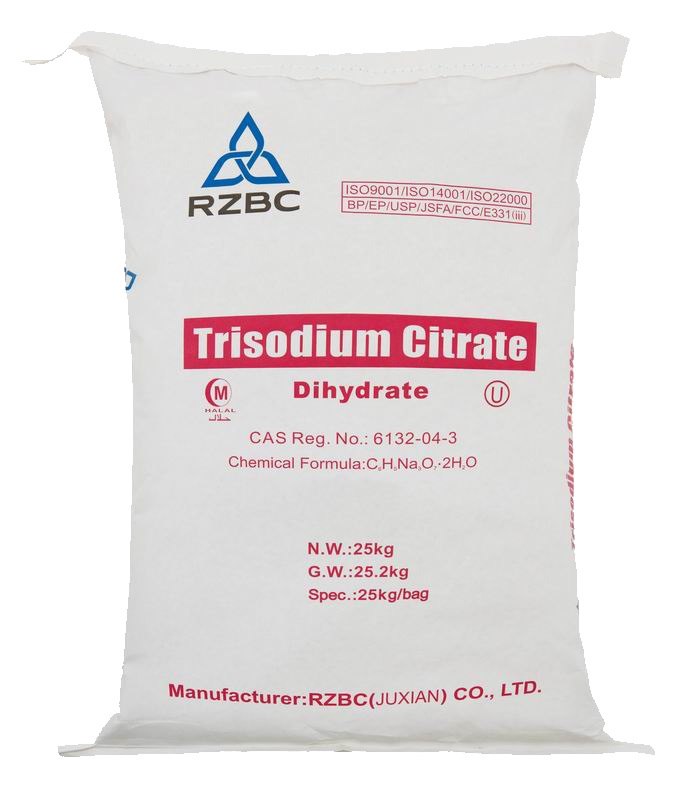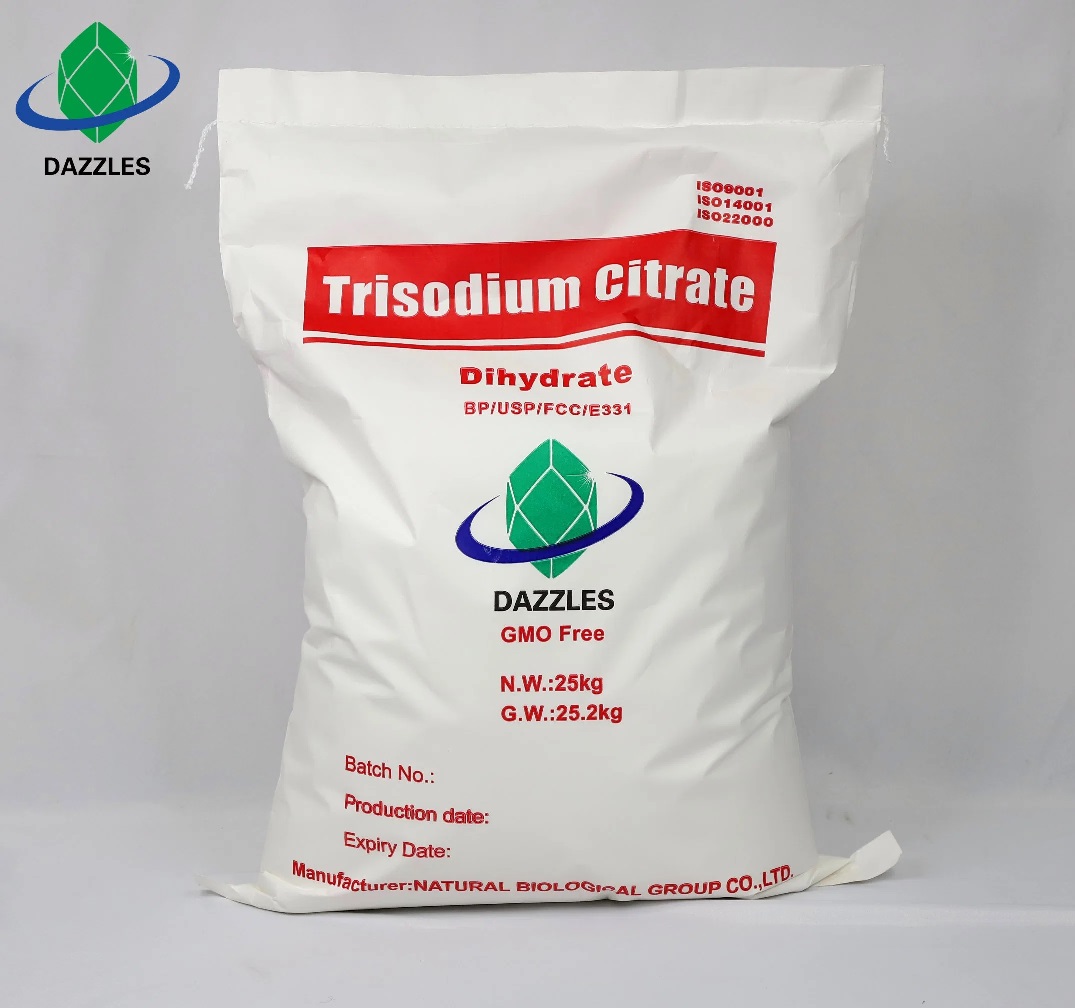We unleash your business potential by maximize the business innovation.
Send EmailTrisodium Citrate, Sodium Citrate, E331, 68-04-2 (Anhydrate) / 6132-04-3
Molecular Formula (Trisodium Citrate); Na3C6H5O7.nH2
Molecular Weight; 258.06 g/mol (Anhydrate) / 294.10 g/mol (Dihydrate)
Chemical Name; Trisodium Citrate Anhydrate or Trisodium Citrate Dihydrate
CAS Number; 68-04-2 (Anhydrate) / 6132-04-3
It is a tribasic salt of citric acid. It is found in 2 forms. One is anhydrate and the other is a dihydrate form.
It is in the class of pharmacological excipients.
Its ability to form complexes with some metal ions is very good. It can form complexes with Ca2+, Mg2+ and Fe2+ ions.
Its solubility in water is good. As the temperature of the water increases, the solubility of Trisodium Citrate increases.
It is a chemical capable of adjusting pH with its buffering feature. It has emulsifying properties.
TSA can absorb moisture, prevent dust agglomeration and extend the shelf life of the product it is used in.
It is a weak acid but has a strong alkaline feature.
When combined with citrate, they can form a pH buffer that creates strong compatibility.
What is Citrate; It is a strong feedback inhibitor of glycolysis to reduce the flux in the event of transport back to the cytosol. It is a Citric Acid ester.
E Code: E331.
Other Names:
1,2,3, Propanetricarboxylic Acid
2-Hydroxy-trisodium salt
Citric Acid trisodium salt
Sodium Citrate
Sodium Citrate Anhydrous
Melting Salt
Citrate
Lemon Salt
Sodium Citrate Anhydrate
Physical and Chemical Properties:
It has a colorless white crystal appearance. It is odorless and has a refreshing salty taste.
Citrate begins to lose its water at temperatures above 150 ° C and decomposes.
Its 5% aqueous solution is approximately pH = 8.5. This is among its most important properties.
It is a compound with very good solubility in water. Its solubility increases as the temperature of water increases.
Its density is 1.76 g/cm3.
It is a stable compound. It has a structure that is incompatible with bases, reducing agents, oxidizing agents.
Trisodium Citrate has low reactivity. It is a chemical that is almost insoluble in ethanol.
It does not have a toxic effect. It has good stability.
Trisodium Citrate Usage Areas:
Trisodium Citrate is in the highest demand as a food additive. It is used as a food additive in the food sector. Its purposes of use in the food sector are as a sweetener, buffering material, emulsifier and stabilizer.
It is a reinforcing agent in cleaning compounds made with magnesium.
Trisodium Citrate is used in the medical field, in blood transfusions, in vitro, in the production of anticoagulant drugs, anticoagulant drugs, expectorants and diuretic drugs.
It is used in the electroplating industry where cyanide is not used.
It is used as an alternative to trimer sodium phosphate in the production of detergents, phosphorus-free and phosphate-free liquid detergents. During detergent production, adding some trisodium citrate to the detergent will increase the cleaning ability of the detergent.
In the Food Sector, it is used as a pH adjusting agent and emulsifying agent in jam, confectionery, ice cream and jelly applications.
It is used as an alkanizing chemical in the medical field. Here, its systemic operation works by neutralizing excess acid in blood and urine. It acts as an indication in the treatment of metabolic acidosis.
The most commonly used emulsifying chemical in the sliced cheese sector is the Dihydrate form. Sodium citrate is used as an emulsifier in the production of fats in cheese production.
Trisodium Citrate is also used in carbonated drinks and wine.
It is used to provide tart flavor in ready-made drinks and beverage mixtures.
Anhydrous Citrate product is 15% porous by volume. Anhydrous citrate can be used to apply the impregnation process with other substances if we add various liquids and other materials. Therefore, it can be used as an anhydrous carrier. In this application, porosity feature provides an advantage.
A certain amount of Trisodium Citrate is used in the production of antifreeze to protect the thermal stabilization of glycol. In this way, glycol deterioration can be prevented.
It is actively used in the production processes of baby food production.
It is used in the pharmaceutical sector together with silicon dioxide and some other chemicals in the production of drops produced for the treatment of abdominal pain.
It is used as a preservative to prevent seafood from spoiling.
It is used to prepare milk protein gel, to prepare protein gel.
It has the ability to make an active buffering that is actively used in pharmaceutical and cosmetic application methods to increase the stability of sodium and potassium citrate and to increase the preservative effectiveness in suitable products.The reason for using it as an antioxidant is that citrate ion has a strong binding for trace metal ions.
Peeled potatoes are exposed to enzymatic browning. To prevent this, they are immersed in Sodium Erythorbate solution at 45-65 °C. Then the potatoes need to be neutralized. For this, trisodium citrate salt is used.
It is used as an acidity regulator together with citric acid in the production of fruit-flavored energy drinks.
It is used blended with salt to control the activity of water in foods cooked at medium humidity.
It prevents the browning reaction by preventing oxygen from reaching the potato surface.

